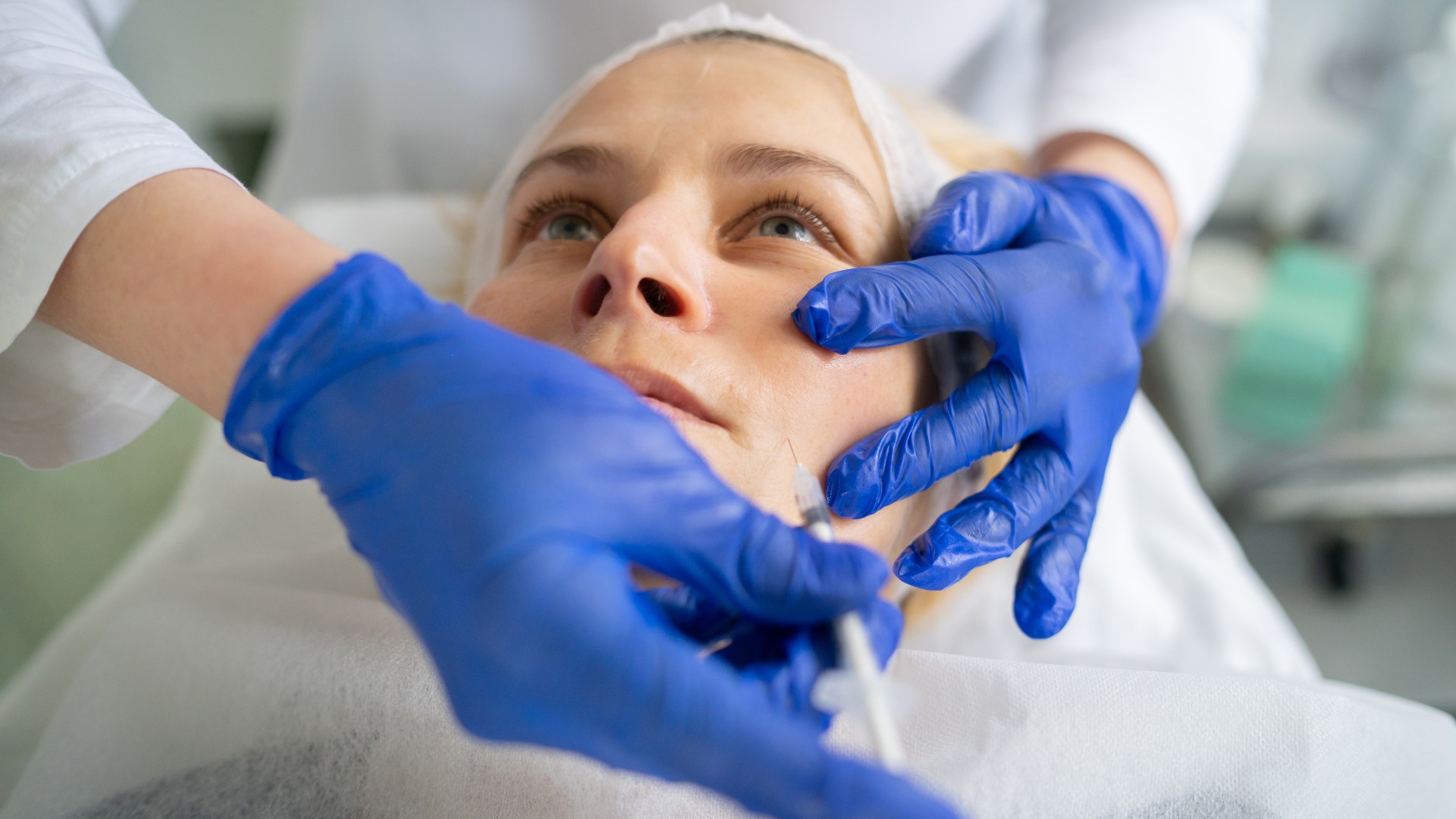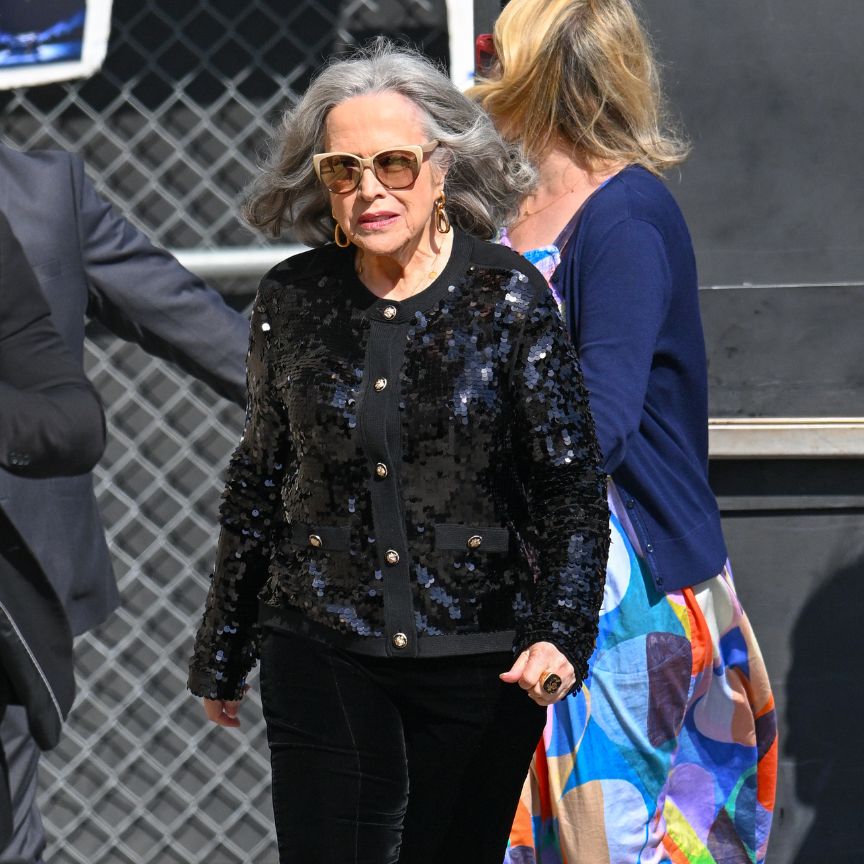Can Dermal Fillers Get Rid of Acne Scars?
We asked dermatologists for the down-low.


If I say “filler,” chances are you’re going to start thinking about plumping up your lips a little bit, sculpting your chin, maybe adding a little something-something to your cheekbones. And while that’s all well and good (you do you), there is another reason you may consider getting dermal fillers in your face—they’re a pretty common treatment for acne scarring. Now let me be abundantly clear: Filler is not a solution for post-inflammatory hyperpigmentation, aka the red or dark marks *temporarily* left behind by acne. It can however be helpful in treating (some) true scars, which are defined as “an indentation or textural change related to the trauma of an acne lesion and has been present for at least a year,” says board-certified dermatologist at Entieré Dermatology Dr. Robert Finney.
A targeted and precise injection (by a skilled professional, please and thanks), has the ability to quite literally fill in depressions in the skin and, over time, stimulate new collagen in the scarred area. But filler isn’t going to be the one-and-done treatment for acne scarring. “Treating acne scars is very difficult because you can’t just do one thing—it ends up being multi-modality,” says board-certified dermatologist and founder of Niche Dermatology Dr. Shari Marchbein. “We might say, ‘Hey, let’s do Fraxel, or let's do microneedling with PRP, or microneedling with radio frequency, or CO2 resurfacing.’ That might be done at a similar time to a laser or filler. We’re talking about a process.”
While treating acne scars is far from a cut-and-dry formula and requires a personalized approach developed in tandem with a board-certified dermatologist, doing your own research is helpful. That’s why we’ve talked to the pros and created a guide to filler for acne scars. Here, you’ll learn what kind of results are tangible, the pros and cons of different types of filler, if you’re a good candidate, risks associated with the treatment, and more. So without further ado, scroll ahead. (For more acne info, check out the best acne spot treatments.)
Can Filler Help Acne Scars?
You guessed it: It’s complicated. While filler can help with acne scarring, it’s typically going to need to be used alongside other treatments (think: lasers, microneedling, resurfacing). Even then, 100 percent improvement on severe scarring is far and few between. “If I can excise your acne scar, inject it with something, and combine it with an energy-based device, it’s going to build your collagen, plump up the scar, and provide a permanent change,” explains Dr. Finney. “Whereas if I treat an acne scar with just filler to plump it up, it will look better, but that filler is going to dissolve. It’s more of a bandaid than a permanent fix.”
What Type of Filler Is Best?
Filler is an overarching umbrella term for a handful of sub-categories. The end goal of all of them is to plump up the appearance of the skin, but they differ ever-so-slightly in how long they last and interact with the tissue. While you should defer to your dermatologist to decide which is best for you, here's an overview.
Bellafill
Bellafill is a specific type of filler that’s FDA-approved for moderate to severe atrophic acne scars in patients over the age of 21. “This is more of a permanent filler,” explains Dr. Marchbein. So, while that might be a positive for some (there’s no need to get new filler every six to 12 months), it’s “hard to remove if you have an issue with it.” Dr. Finney adds that, while rare, there have been reports of the body treating Bellafill like a foreign material. “Once that happens, you’re going to have to surgically excise that material. The risks are pretty low, but to me if you can avoid it, it’s not worth it,” he says.
Hyaluronic Acid Fillers
Popular brands like Juvederm and Restylane fall into the hyaluronic acid filler category, which is preferred by Dr. Marchbein. “The nice thing about hyaluronic acid fillers is that it stimulates collagen around the scar as well, which can help scarring on a permanent level. I find that, for some patients, if we do a few treatments every six to 12 months, it ends up having a really long-lasting effect where the filler can last for years and years,” says Dr. Marchbein.
Stay In The Know
Get exclusive access to fashion and beauty trends, hot-off-the-press celebrity news, and more.
Biostimulatory Fillers
Biostimulatory fillers, like Radiesse or Sculptra, are slightly different from hyaluronic acid-based fillers. While they will give a temporary plumping effect, their main goal is to stimulate collagen production, which is why they’re Dr. Finney’s preferred choice. “Any time you have a textural change, you have bad collagen that’s binding that skin down,” he explains. That is why as he injects the filler into the scar, breaks up the band of bad collagen with the needle. In turn, his patients get a more plumped appearance in the short term and more permanent improvement in the long term.
Who’s a Candidate for Filler?
Filler isn't a treatment option for everyone. While it can be used in tandem with or following other treatments like resurfacing lasers, its viability is largely determined by two factors.
Someone With Clear Skin
No doctor is going to recommend filler, or any other scar treatment for that matter, if you’re still dealing with active breakouts. “You have to put out the fire before you paint the house,” says Dr. Marchbein. “Nobody in their right mind is going to have you pay money to treat your acne scars while your actively breaking out. The reason is—number one—any additional breakouts that you have can contribute to further scarring, so it becomes a waste of money. And number two, a lot of the treatments for acne, such as retinoids, chemical peels at home or in office, and even topical peptides can build collagen.” Those products alone can make a visible difference in how severe scarring appears.
Someone With the *Right* Type of Scar
There are three main types of acne scars: Boxcar scars, rolling scars, and ice pick scars. “Boxcar means the scars are shallow but wide with defined edges; Rolling are undulating—they’re wide with a shallow depth; Ice pick scarring is very narrow,” explains Dr. Finney. While fillers are a worthwhile treatment for the former two, it’s not going to work on the latter. “No filler is going to be able to plump up a scar that’s very narrow and deep. But if your scars are undulating or you’re dealing with a textural change, filler can work really well.”
How to Care for Skin After Filler
While you’ll want to follow all the typical aftercare rules (read: no intense cardio, no alcohol, so on and so forth), Dr. Marchbein stresses that, contrary to normal injections, you’re going to want to avoid massaging the area. “I don’t do any massaging because you don’t want to move the filler out of that little indent or well. Just leave it where it is and it’ll settle on its own in about two weeks,” she explains. “We want it to stay exactly where we injected it and directed it.”
In a similar vein, Dr. Finney advises all his patients to sleep on their backs. “For the first two weeks, filler is more malleable. It’s going to be a little swollen. It’s going to be a little lumpy-bumpy. That’ll settle down and if you can sleep on your back, there’s less pressure on the area and you’re not manipulating its position,” he explains.
Is There Downtime After Filler?
The second you get your filler, you’re good to go about your day. As Dr. Marchbein mentioned, the filler should be fully settled in within two weeks, but you will see results right away. That’s in part what makes filler an enticing option. Energy-based devices are going to be a more long-term commitment with results fully visible in around a year. “If you have a big event coming up and need a simple fix to help improve appearance and texture, fillers are a good option,” says Dr. Finney.
How Much Does it Cost to Get Filler in Acne Scars?
Chances are you will need a handful of different treatments to effectively get rid of acne scarring. But when assessing standalone treatments, I will say that filler is going to be more cost effective. “For lasers, we’re talking about three to six sessions. It’s going to cost someone at least $4,500 to $5,000,” says Dr. Marchbein. “With filler, you might be talking about $950 or $1,000, depending on how many syringes someone needs.” (And of course, price varies based on location.)
On the downside though, it is possible you end up paying for more filler than you need—depending on how many scars you're treating. “If you’re treating one acne scar, you’re paying for a syringe, but only probably using one-tenth of it,” says Dr. Finney. That said, you can likely use the filler in other areas of your face if you so choose.
What Are the Risks Associated With Filler for Acne Scars?
Your provider should go over any and all risks associated with your personalized treatment. That said, the biggest factor to consider when getting filler is the possibility of the filler getting injected into an artery or a blood vessel, which can cause necrosis, or the death of skin tissue. “We should be able to see this happen in real time. If you inject into an artery, you get a blanching pattern almost immediately. The best treatment is hyaluronidase, which dissolves hyaluronic filler at that moment,” explains Dr. Finney. Unfortunately, not all medspas or providers are equipped to deal with complications. That’s why your best bet is to get the procedure done with a board-certified dermatologist.
Meet the Dermatologists

Originally from Pittsburgh, PA, Dr. Finney completed his undergraduate and medical degrees at Pennsylvania State University. He completed his internship and dermatology residency at Thomas Jefferson University Hospital in Philadelphia, PA where he served as chief resident during his final year. He also performed a postdoctoral research fellowship in eczema and allergic contact dermatitis at Rockefeller University in addition to an advanced fellowship in aesthetics, hair restoration, and skin surgery with renowned hair surgeon Dr. Marc Avram in New York. Dr. Finney is a clinical assistant professor at New York University Langone and teaches future dermatologists at Bellevue Hospital. Dr. Finney is an expert in medical, surgical, and cosmetic dermatology and is regularly asked to contribute to various media outlets, including Men’s Health, Men’s Journal, Esquire, and Women’s Health. He does not approach aesthetics from a cookie-cutter approach, rather he works closely with each patient to design a customized treatment regimen to achieve his or her desired aesthetic outcomes that appear natural and refreshed, never over-done.

Dr. Shari Marchbein is a board-certified dermatologist and a fellow of the American Academy of Dermatology. Dr. Marchbein’s academic and clinical interests include the treatment of acne, in particular adult female acne, acne scarring, and rosacea. She also specializes in various aesthetic procedures and laser surgery. Dr. Marchbein has been sought out as a leader in her field for the treatment of acne and rosacea and has published multiple articles on acne pathogenesis and treatment. She has presented at renowned national conferences on the topics of acne and rosacea, including the annual American Academy of Dermatology and Advances in Dermatology meetings. Dr. Marchbein earned her Bachelor of Science degree from the State University of New York at Binghamton where she graduated Summa Cum Laude and became a member of the Golden Key National Honor Society and Phi Beta Kappa National Honor Society.

Samantha Holender is the Senior Beauty Editor at Marie Claire, where she reports on the best new launches, dives into the science behind skincare, and shares the breakdown on the latest and greatest trends in the beauty space. She's studied up on every ingredient you'll find on INCI list and is constantly in search of the world's glowiest makeup products. She's constantly tracking the biggest nail and hair trends to pop up in the beauty space, going backstage during fashion weeks, tracking celebrity looks, and constantly talking to celebrity hair stylists, nail artists, and makeup artists. Prior to joining the team, she worked as Us Weekly’s Beauty and Style Editor, where she stayed on the pulse of pop culture and broke down celebrity beauty routines, hair transformations, and red carpet looks. Her words have also appeared on Popsugar, Makeup.com, Skincare.com, Delish.com, and Philadelphia Wedding. Samantha also serves as a board member for the American Society of Magazine Editors (ASME). She first joined the organization in 2018, when she worked as an editorial intern at Food Network Magazine and Pioneer Woman Magazine. Samantha has a degree in Journalism and Mass Communications from The George Washington University’s School of Media and Public Affairs. While at GWU, she was a founding member of the school’s HerCampus chapter and served as its President for four years. When she’s not deep in the beauty closet or swatching eyeshadows, you can find her obsessing over Real Housewives and all things Bravo. Keep up with her on Instagram @samholender.
-
 Princess Beatrice's Husband Pays a Rare Tribute to These Royal Family Members on Instagram
Princess Beatrice's Husband Pays a Rare Tribute to These Royal Family Members on InstagramEdoardo Mapelli Mozzi shared some behind-the-scenes snaps from the F1 Grand Prix in Bahrain.
By Kristin Contino
-
 Allow Kathy Bates to Convince You to Grow Out Your Grays
Allow Kathy Bates to Convince You to Grow Out Your GraysOne look at her new style and you'll be canceling your root touch-up pronto.
By Ariel Baker
-
 After the 'Yellowjackets' Finale Answered Many of Our Burning Questions, Will It Return for Season 4?
After the 'Yellowjackets' Finale Answered Many of Our Burning Questions, Will It Return for Season 4?The showrunners still have plans to show how the girls get out of the wilderness.
By Quinci LeGardye